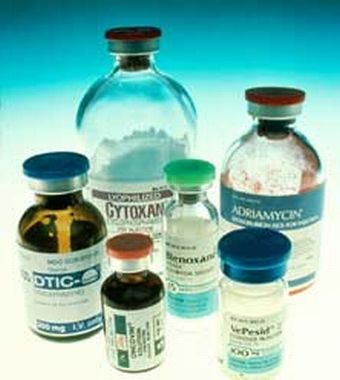
Publisher:
Bonnie King
CONTACT:
Newsroom@Salem-news.com
Advertising:
Adsales@Salem-news.com

~Truth~
~Justice~
~Peace~
TJP
Dec-29-2008 18:16

 TweetFollow @OregonNews
TweetFollow @OregonNews
Errors Involving Chemotherapy Medications Common in Outpatient Cancer Treatment
Salem-News.comA study indicates that among the 7 percent of medication errors involving adults, 55 had the potential to harm the patient and 11 did cause harm.
 Chemotherapy drugs Courtesy: thecancerblog.org |
(WASHINGTON, D.C.) - Seven percent of adults and 19 percent of children taking chemotherapy drugs in outpatient clinics or at home were given the wrong dose or experienced other mistakes involving their medications, according to a new study supported in part by HHS’ Agency for Healthcare Research and Quality through its Centers for Education and Research on Therapeutics program.
Researchers analyzed data on nearly 1,300 patient visits at three adult oncology outpatient clinics and 117 visits at one pediatric facility between September 1st, 2005 and May 31st, 2006.
The study, “Medication Errors among Adults and Children with Cancer in the Outpatient Setting,” is in the January 1st, 2009 issue of the Journal of Clinical Oncology.
Of the 7 percent of medication errors involving adults, 55 had the potential to harm the patient and 11 did cause harm.
The errors included administration of incorrect medication doses due to confusion over conflicting orders – one written at the time of diagnosis and the other on the day of administration.
Some consequences of errors included patients being over-hydrated prior to administration of chemotherapy and complaints of abdominal pain in patients taking narcotics without treatment for constipation.
More than 50 percent of errors involving adults were in clinic administration, 28 percent in ordering of medications, and 7 percent in use of the drugs in patients’ homes.
About 40 percent of the 22 medication errors in children had the potential to cause harm and four children were harmed.
Examples of pediatric errors included giving the wrong amount or the wrong number of times a day for home medicines because of confusion about instructions.
In children more than 70 percent of the errors in children occurred at home.
According to the study’s leader, Kathleen E. Walsh, M.D., an assistant professor of pediatrics at the University of Massachusetts School of Medicine and a Robert Wood Johnson Physician Faculty Scholars Award recipient, avoiding prewriting of chemotherapy orders in adults in outpatient clinics may have prevented many of the errors in the adults, whereas most of those involving children could have been avoided by better communication, training, and support for parents of children who use chemotherapy medications at home.
Source: Bob Isquith / U.S. Department of Health and Human Services
Articles for December 28, 2008 | Articles for December 29, 2008 | Articles for December 30, 2008

googlec507860f6901db00.html
Salem-News.com:



Terms of Service | Privacy Policy
All comments and messages are approved by people and self promotional links or unacceptable comments are denied.
[Return to Top]
©2025 Salem-News.com. All opinions expressed in this article are those of the author and do not necessarily reflect those of Salem-News.com.